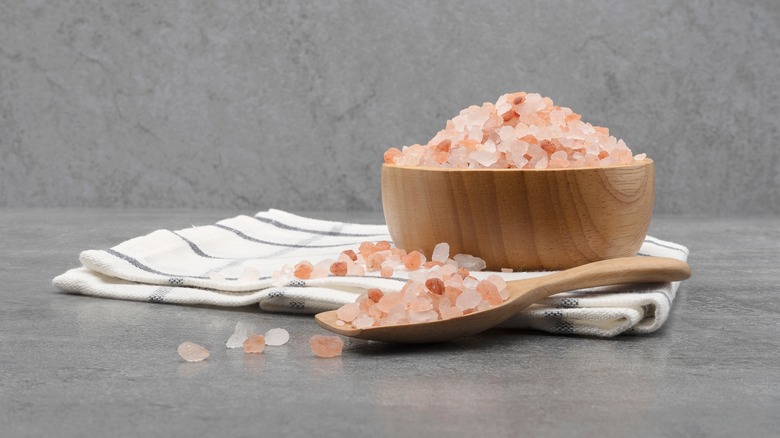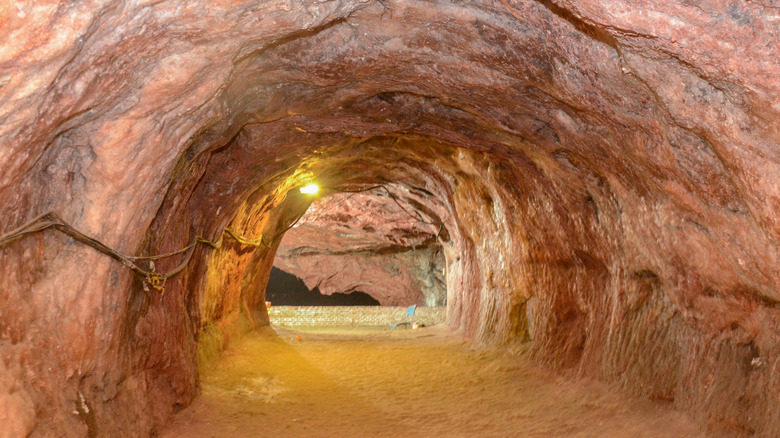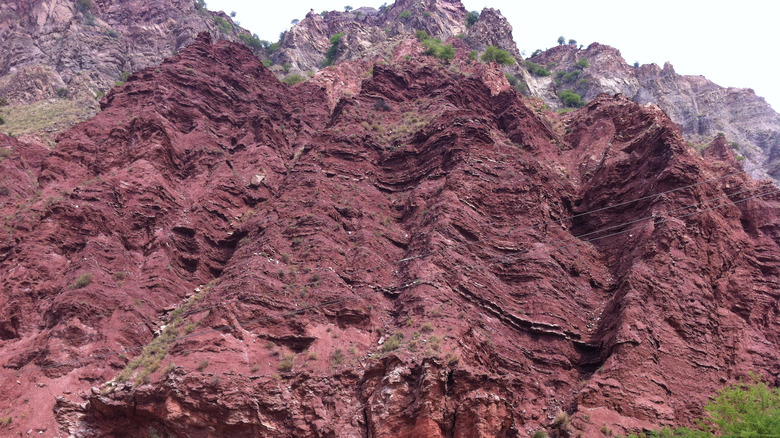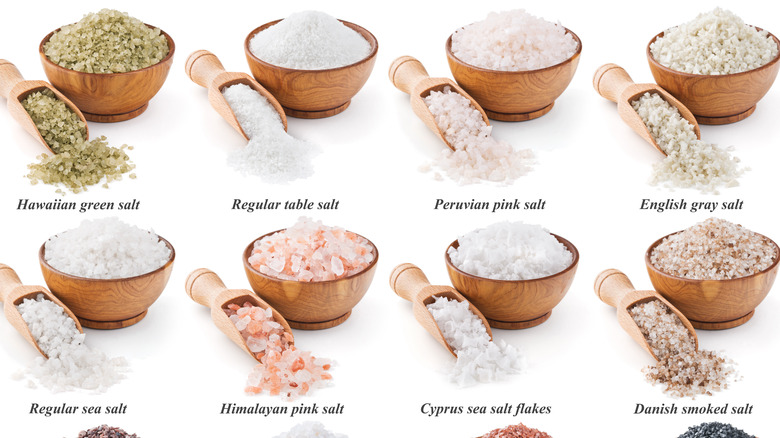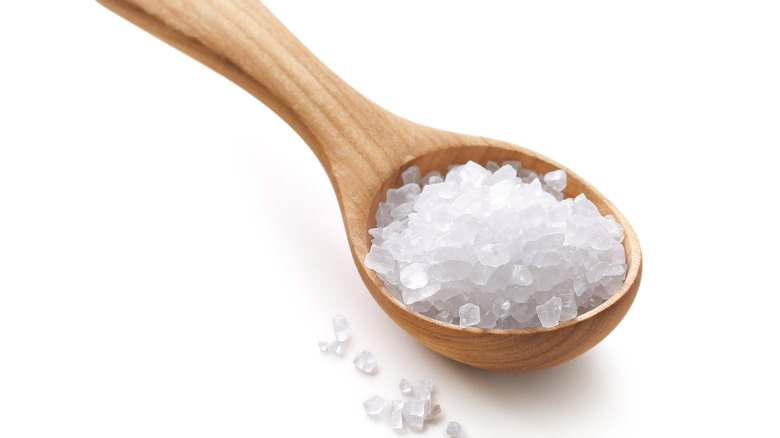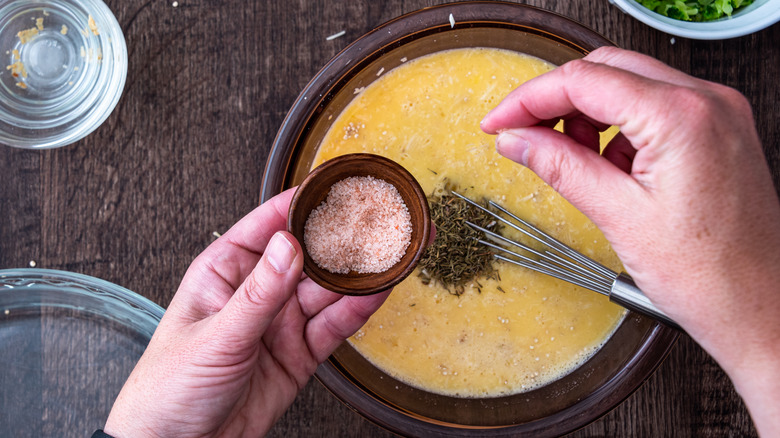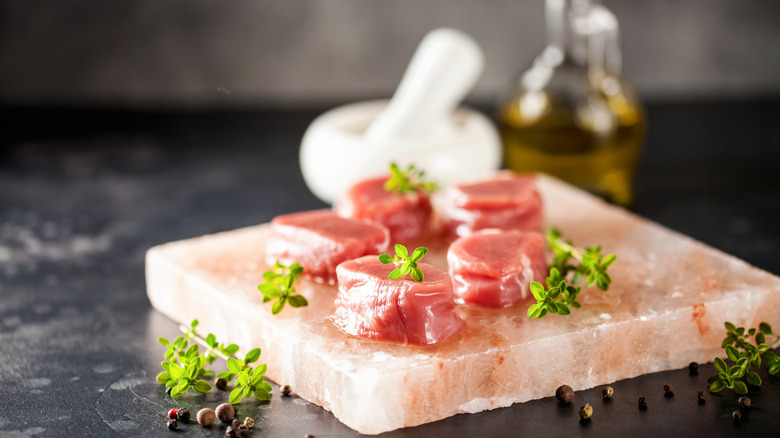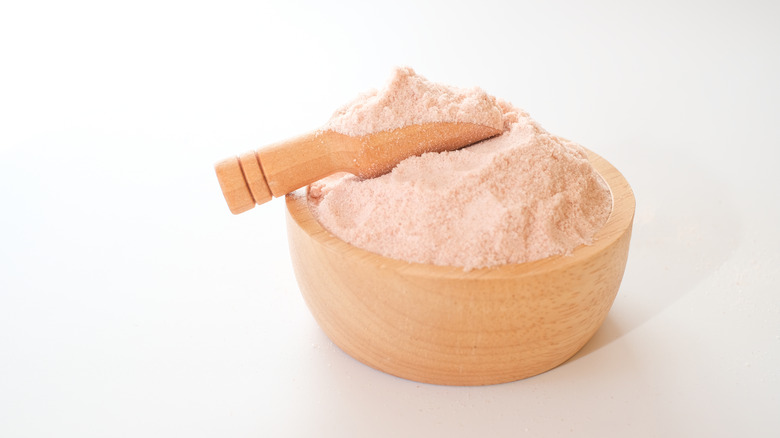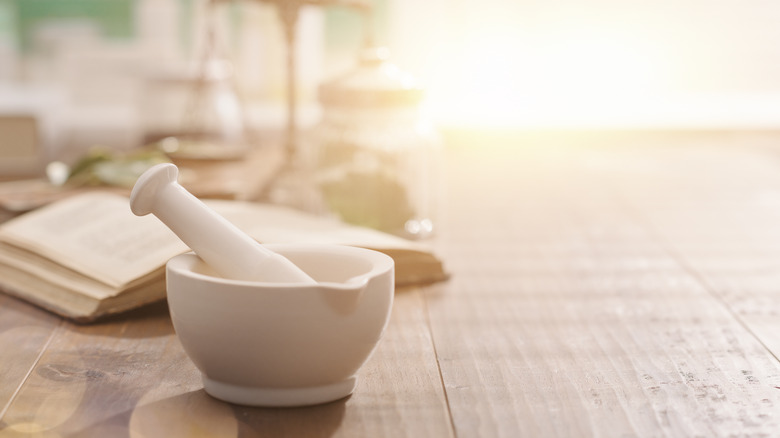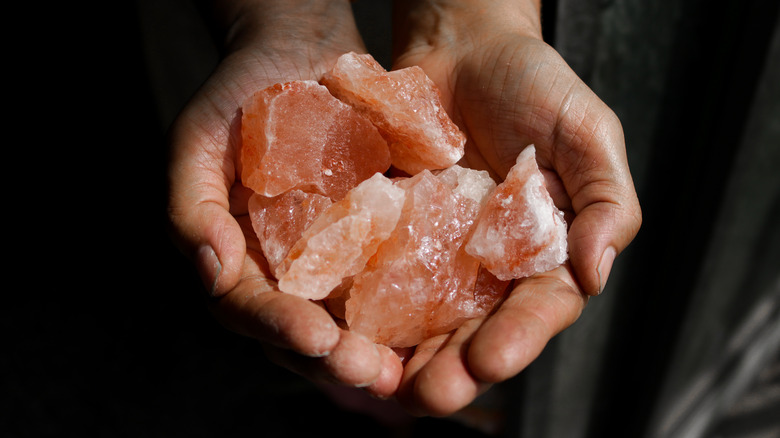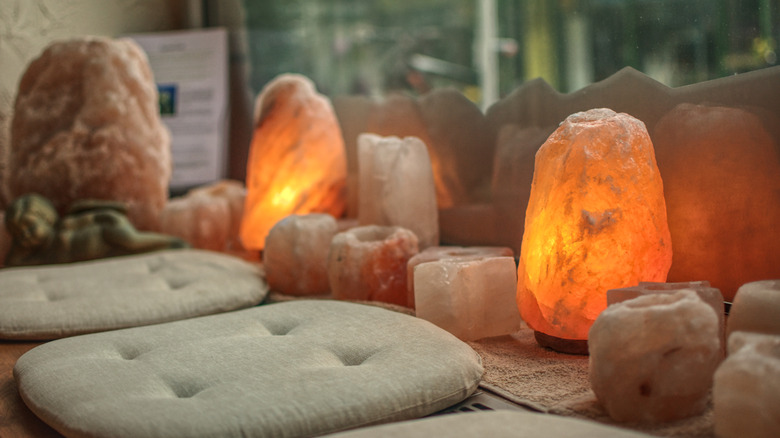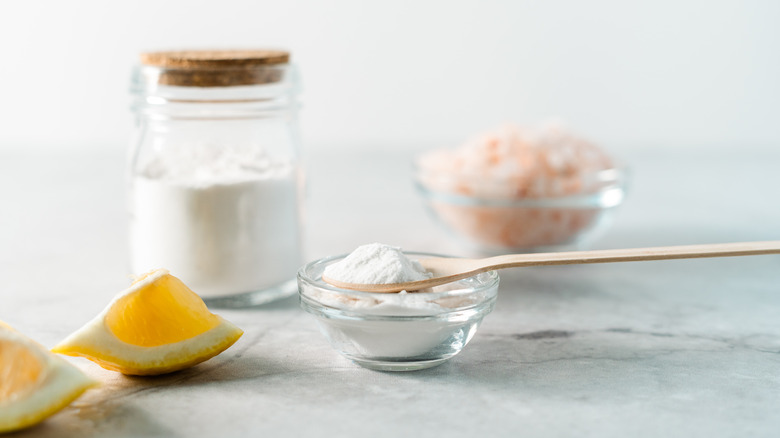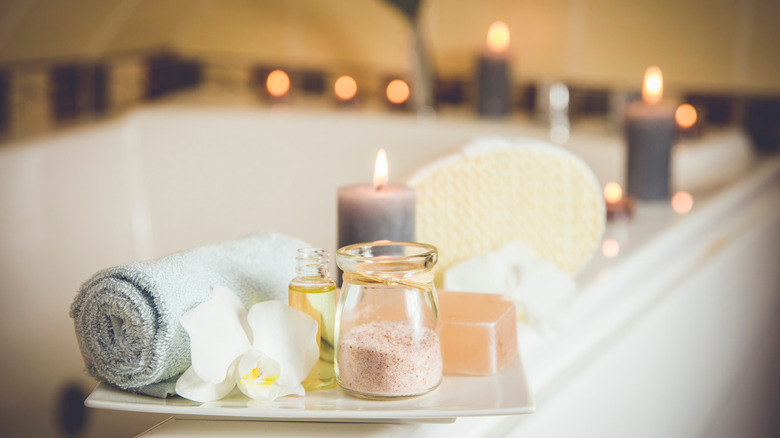The Ultimate Guide To Himalayan Sea Salt
Himalayan salt is so much more than a fancy name for regular table salt. It can be used in a myriad of ways, such as cooking and cleaning — and it even has a miraculous number of health benefits. Typically, a light to medium pink color, and even occasionally black, the appearance of Himalayan salt isn't the only difference between it and white salt; however, they are often used interchangeably, especially in the kitchen.
Himalayan salt has a somewhat literal name as it is formed and mined in the regions surrounding the Himalayas, a 1,500-mile-long mountain range found in Asia, which crosses several countries, explains PBS. The salt that is mined today for tables and pantries across the world formed millions of years ago when an ancient sea dried up. The salt that was left behind crystalized and was then buried by rock and stone. As earthquakes and geological shifts occurred, mountains formed over the salt deposits and now must be mined by hand in order to harvest the pink gold (via SaltWorks). The mines, which are covered in glass-like pinkish hunks of salt, are actually a tourist attraction and bring thousands of visitors each year.
Catching a glimpse of the salt can be quite an experience, especially considering how much salt is there. In fact, it's unknown how much salt actually exists in the region, but researchers and miners do not anticipate running out anytime soon.
How Himalayan salt is mined
It's been rumored that Alexander the Great first discovered the salt during his travels when his horses began to investigate and lick nearby rocks, according to SaltWorks. However, the majority of the salt is found deep within the mountains and must be extracted from caves before it can be processed.
According to Business Insider, this bustling business of salt mining gained attention in the 1800s, but the actual mining process hasn't changed much over the years. The communities around the mines rely on the business — and the uptick in popularity that occurred in the 2000s only increased the amount of salt being harvested. Although the miners must create an opening into the mountains with explosives, the process after that is pretty basic. The miners use traditional tools such as hand drills, which they use to make holes in the walls — gunpowder is also used — and then the blocks of salt are hauled away, but the process is less invasive than it sounds. The mines are not cleared out and left barren. In fact, only half of the salt is harvested and the other half is carved and used as supportive pillars to keep the caves and walls steady. This ingenious technique hasn't changed much over the years and still the miners manage to harvest approximately 800 million pounds of salt per year.
How does mining Himalayan salt impact the environment and communities
The largest Himalayan salt mines are located in Pakistan; however, for years the country did not receive the recognition nor the financial benefits of such a lucrative business. In fact, there are often many misconceptions about where the salt comes from and the environmental impact of salt mining, according to Business Insider. When Pakistan began mining Himalayan salt they were not equipped to process the salt and it was therefore shipped to India. Because the salt was processed there, it was marketed as being from India. However, in the past five years, the Pakistani government has been working to process the salt in their homeland.
In terms of sustainability, the preservation of the mountains is very important. Because so many residents in the area live there and depend on the mines, the use of explosives is extremely limited, according to SaltWorks. Mining by hand with traditional tools also limits pollution and prevents negative impacts on wildlife and animal life in the area.
Himalayan salt versus other salts
The big question is how does Himalayan salt, pink or black compare to table salt and other forms of salt? The answer is that most salts are used interchangeably — although they may differ in color and texture, the flavors are often similar. Salt can either be harvested from a mine or from evaporated seawater, or it can actually be man-made, according to Ittefaq Trading Co. The composition of most salts is mainly the same though. Salt is made up of sodium chloride and although some kinds are smoked slowly and have a smokier flavor, the taste is comparable as well.
The most common form of salt is table salt and although it's not man-made it is heavily treated to get that crisp white color and to prevent it from clumping, which means other, not always healthy, additives are involved. Kosher salt is another common form and it's similar to table salt but comes in bigger flakes. Several other kinds of salt originate from different seawaters around the world. When they evaporate, the salt is left behind. These forms are less common but come from areas such as the coast of France and Hawaii.
Himalayan salt is often considered one of the purest forms of salt because it formed so long ago and is protected by the mountains; however, humans have also altered it in some forms. Black Himalayan salt is much darker because it is baked very slowly with charcoal and other herbs to give it a slightly different flavor and darker color.
Pink versus white
Himalayan salt is most commonly found to have light pink hues to deeper pink but occasionally has orangish-red tints, according to Saltability. On very rare occasions, Himalayan salt appears white and this can mean that it has slightly more health benefits than the pink stuff. The white appearance is a marker for higher levels of iron oxide.
If you've heard or read that Himalayan salt lamps can help relax you or even combat positive ions, it's because of the iron oxide. The minerals can help fight against things such as mold, pet dander, even chemicals, and other positive ions which can occur in your home or office, according to Holistic Lakewood.
White salt can be found intermixed with your Himalayan salt and is often found in salt caves and walls that are used for spa purposes. The health benefits make it slightly more desirable for beauty and health treatments but in terms of taste, it's the same.
How to cook with Himalayan salt
Salt is a condiment, which means it is primarily used for adding to or enhancing the flavor of certain dishes. Harvard School of Health explains that too much salt and sodium can lead to health problems like higher blood pressure and cholesterol — our bodies, however, need some salt to survive. The pink version is an excellent alternative that can boost your recipes in a safer way when trying to find that balance.
Next time you're baking, consider swapping out table salt for Himalayan salt. The option is healthier and some foodies even swear the pink stuff is slightly sweeter. Sprinkle the pink gold over hot dishes, into salads, over warm pretzels, or even into your water for added electrolytes, according to Himalayans Finest. Something to remember about cooking with Himalayan salt is that you might find larger chunks that require a little more grinding or a little more heat before they dissolve. Added flavor is great, but pay attention to the coarser texture, and don't serve your guests undissolved salt. However, the coarser kind works great for marinades and rubs.
Cooking with pink Himalayan salt or even displaying it in a beautiful glass jar is one simple way to spice up your kitchen. The beautiful pinks are more exciting and your guests, family, and friends will love hearing about the health benefits of the added flavor.
Cooking or grilling on a Himalayan salt block
If you're feeling extra adventurous, you can kick things up a notch and try out a Himalayan salt block in the kitchen. According to Healthline, this trend is gaining attention because of the aesthetic of a salt block, the added minerals, and flavor, and the blocks are actually very good at retaining heat. Pink salt blocks are essentially a chunk of salt that is cut into a slab, platter, or tray-like shape. The surface is typically smooth and can be used for serving hot and cold foods, or baking and grilling.
Salt blocks can be slowly heated up either in an oven or on a grill to very high temperatures. Once the temp rises, you can then cook foods such as meats, fish, eggs, and vegetables on the surface. Be sure to treat the surface the same as any other hot surface and remember to slowly increase the temperature of the block or it could crack. Baking or grilling meats is the most common way to use a salt block as it adds minerals and flavor to the foods. When cooking with a block, remember that too many liquids or water can also cause cracking and you should stick to wiping the surface down to clean it, as too much water can also dissolve the salt.
Serving with a salt block tray is also common because it creates a beautiful display and it can keep foods hot or cold while serving as long as it has slowly been brought to the desired temperature.
How to store salt long term
If you're a bulk buyer because it saves money or is better for the environment or if you prefer to have a lot of supplies on hand in case of an emergency, you may be wondering about the best way to store Himalayan salt. Salt is a little bit of a miraculous condiment. It occurs naturally, boosts flavor, can be used for preserving foods, and it will stay fresh indefinitely if stored properly, according to The Provident Prepper. Salt may be a natural wonder, but it also isn't perfect. The natural makeup of the minerals will attract moisture and it will absorb certain scents, which can ultimately make the salt clumpy and hard and could even alter the taste.
However, an airtight, cool dark storage place is the answer to all of these challenges. Store your salt either in its original packaging or move it into a container, as long as it can be sealed airtight. The sodium chloride will remain the same and ensure that the salt doesn't lose freshness or flavor even for years and years. Salt seems to be plentiful right now, but with inflation and shortages around the world we can never quite predict when an ingredient or product will be hard to come by. If there's anything you are considering stocking up on, let it be Himalayan salt. The condiment can be used in so many dishes and it can help preserve food in a pinch.
The benefits of grinding salt yourself
If you're browsing your supermarket and spot Himalayan salt in a grinder, should you buy it or buy the coarser salt? According to Grindly, grinding salt yourself can make it easier to sprinkle over dishes, help it dissolve faster, and give you the opportunity to mix in your own flavors. However, the fact of the matter is that this debate is mainly up to personal preference. Sodium chloride is a stable compound, which means grinding it fresh or giving it more or less time to react with oxygen really makes no difference when it comes to taste. Fresh ground salt won't really taste any fresher or enhance the flavor.
However, grinding your salt can be great for other reasons. First of all, coarser salt could be cheaper because it's one less step in the process for manufacturers. Not to mention, coarse salt does not always dissolve and can feel a little like a small pebble if it remains too coarse. Grinding salt can either be a fun extra step that makes cooking a little more adventurous — especially if you use a mortar and pestle — or it can be a time-consuming nuisance that slows down your prep time. Personal preference will determine if you need to grind up the salt yourself.
Himalayan salt health benefits
Health and wellness is a huge industry, particularly as we learn more about our habits with regard to cellphones and other technology — and we continue to pack our schedules to the brim. There's quite a lot of hype, but what are the actual health benefits of Himalayan salt?
According to PharmEasy, Himalayan salt naturally contains several elements that are beneficial for humans, albeit in small amounts. Calcium, potassium, iron, and magnesium are just a few of the more well-known minerals found in Himalayan salt. The common condiment makes it easy to incorporate more of these into your everyday diet. In addition, Himalayan salt is believed to contribute to better sleep, less stress, higher serotonin levels, and improved digestion.
Chunks of Himalayan salt, whether it becomes a lamp, a block, or a detoxifying bar, may also help reduce the effects of nearby electronics and other tech devices, such as fatigue and even depression. According to Ion Loop, in addition to dust and pollen and other toxins in the air, phones, computers, televisions, and certain lighting can positively charge molecules in the air and become extremely concentrated in areas like homes and offices. This could result in an overall sense of stress or anxiety. Himalayan salt blocks could counteract these positive ions with negative ions and help purify the air, or simply make you feel more connected to the outdoors (via Himalayan Salt Company).
Salty trends: lamps and caves
Hailed as a miracle by some and as totally ridiculous by others, it's hard to determine the truth when it comes to trends. Himalayan salt is believed to contain more minerals and less actual sodium chloride than table salt, which is also typically bleached to achieve the white color and filled with additives. According to the Cleveland Clinic, Himalayan salt lamps are believed to produce negative ions, which work to combat positive ions that are commonly found in dust, pollen, mold, and dander. These contaminants often contribute to allergies, lung health, and other respiratory issues, which is why salt caves and lamps are believed to treat these symptoms.
In addition, the popular salt lamps, which have a light bulb inside the block and usually contain a base of some sort, are believed to boost overall mood and purify the air. Negative ions can do wonders for cleaner air and may even elevate your mood, but the general consensus is that the popular salt lamps do not produce nearly enough to feel the effects. Salt caves on the other hand produce a lot more negative ions more and could leave you feeling refreshed and/or able to breathe easier. However, the warm and relaxing glow and the natural look of the lamp could be enough to make you feel happier, more inspired, or even more relaxed and that's always a plus.
Cleaning with Himalayan salt
The wonders of Himalayan salt go far beyond cooking and health benefits. In fact, this type of salt is an excellent addition to your cleaning supplies and it's effective, non-toxic, and affordable. According to Himalayan Salt Company, there is a myriad of cleaning hacks with Himalayan salt to help everywhere in your home from the kitchen to the bathroom.
Starting in the kitchen, Himalayan salt, especially coarse salt, can be great for fighting grease on your pots and pans. Sprinkle a little salt mixed with soap onto your pans and it will give your sponge extra scrubbing power. Coffee and tea stains on mugs can be tough to scrub out, but adding a bit of salt, and allowing it to sit for a few minutes will make easy work of the stains. The next time you have a clogged drain, consider pouring equal parts baking soda and Himalayan salt down the drain and flushing it out with white vinegar to clear any blockages.
Himalayan salt also has plenty of uses in the bathroom. Fight water stains and mildew in and around the shower with a mixture of salt and vinegar or lemon juice. This is an easy non-toxic way to keep your tiles and tub sparkling. Salt is also great at absorbing moisture and odors, consider adding a bowl or container of salt behind the toilet or under the sink to keep the air feeling fresh.
Other uses for Himalayan salt
If you're not already completely impressed by Himalayan salt, consider even more ways to make use of the natural wonder. According to Natural Living Ideas, salt can be an excellent addition to your bath. Transform your tub into a luxurious spa by adding a few spoonfuls of Himalayan salt to create a soft, relaxing, detoxifying soak. If you don't have time for a bath, consider a foot bath. Salt is great at drawing toxins out of your body and a relaxing soak for your tired feet can leave you feeling refreshed.
In addition, saline rinses are used for many ailments, including sinus infections, and can be used as a mouthwash to heal and fight bacteria. Think about how your skin feels after a dip in the ocean. It usually feels softer and slightly tighter. Utilize the natural healing properties of Himalayan salt for your skin and massage it into your scalp or arms and legs with a splash of water before your next shower. If you're feeling more adventurous there are endless DIY salt scrub recipes and even deodorant recipes that require Himalayan salt. The possibilities for Himalayan salt are seemingly endless with a little research and creativity.
